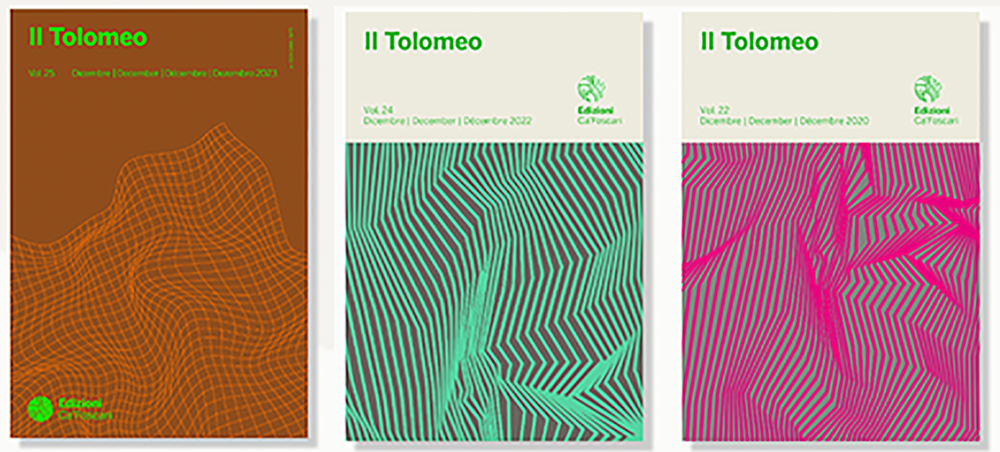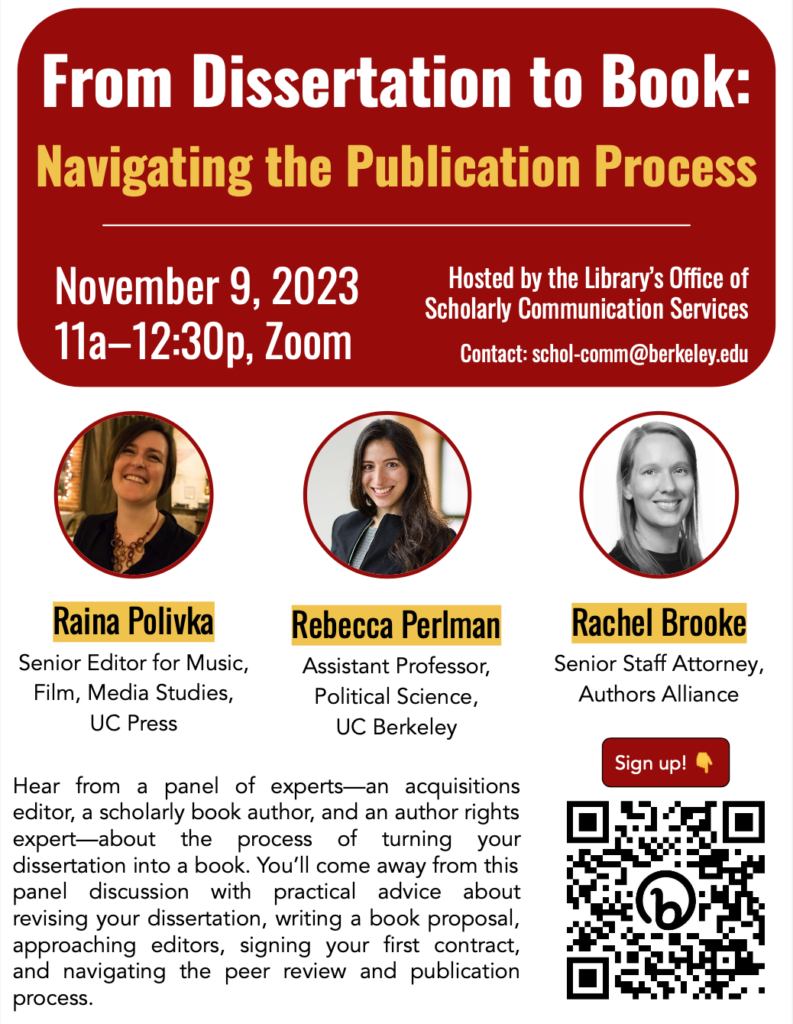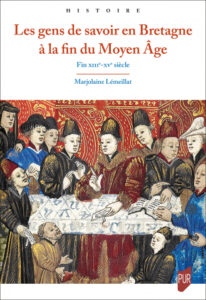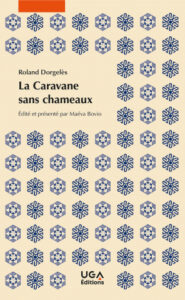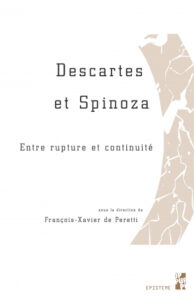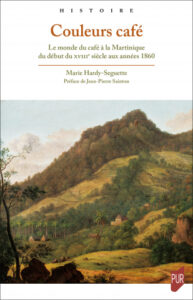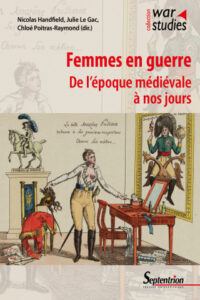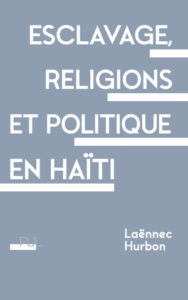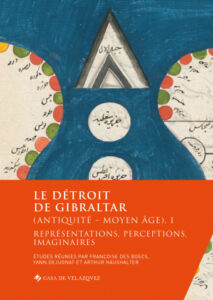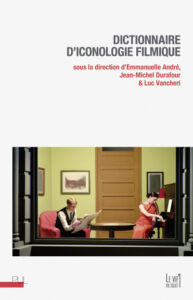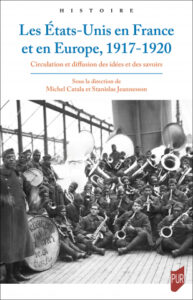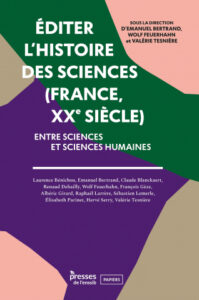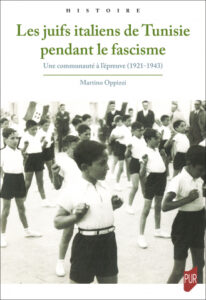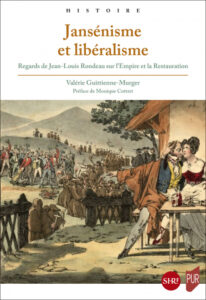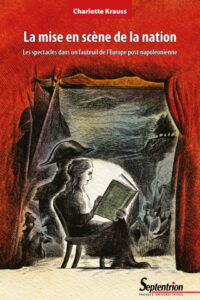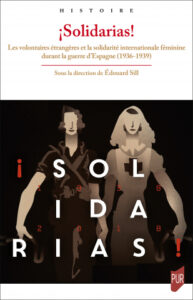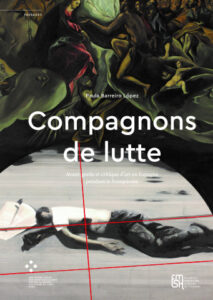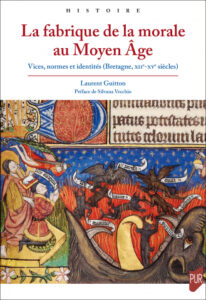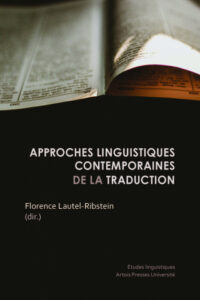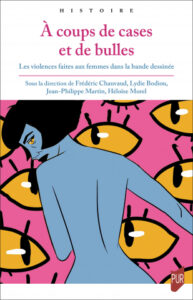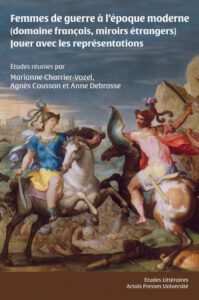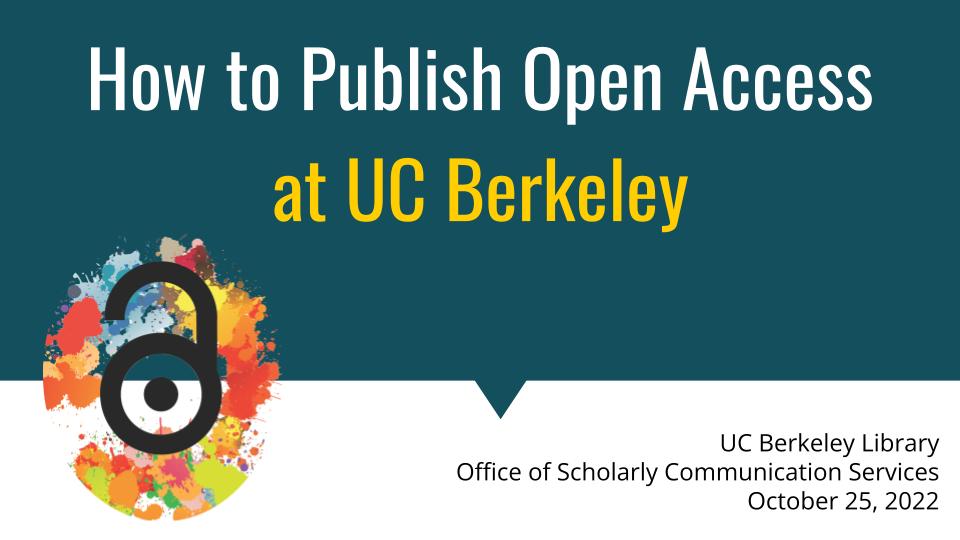Tag: open access
Supporting open access book publishing at UC Berkeley: Spring 2024 update
UC Berkeley supports a variety of ways our authors can participate in open access publishing. At its heart, open access literature is “digital, online, free of charge, and free of most copyright and licensing restrictions” (Suber, 2019). Open access materials can be read and used by anyone.
But you might be wondering, why is UC Berkeley concerned about trying to make research more openly available and accessible? Well, one fundamental reason is that the research and teaching mission of the UC includes the aim of “transmitting advanced knowledge,” and as part of doing that, our faculty, researchers, and students create and share their scholarship.
This system of scholarly publishing includes traditional publications such as peer-reviewed academic articles, scholarly chapters or books, and conference proceedings. It also includes other types of publications such as digital projects, data sets and visualizations, and working papers.
In this blog post, we first touch briefly on how the UC Berkeley Library is fostering open access publishing for journal articles, and then dive deeper into the innovative ways we’re supporting open access publishing for books.
Library Support for Open Access Articles
UC Berkeley offers a wide range of support to help authors publish scholarly articles. The UC’s system wide Open Access Policies ensure that university-affiliated authors can deposit their final, peer-reviewed research articles into eScholarship, our institutional repository, immediately upon publication in a journal. Once they’re in eScholarship, the articles may be read by anyone for free.
As of February 2024, the University of California has entered into 24 transformative open access publishing agreements with scholarly publishers. These agreements permit UC corresponding authors to publish open access in covered journals, with the publishing fees being covered in part (or in full) by the UC. In fiscal year 2022-23 UC Berkeley authors published 348 open access articles as a part of these system wide open access publishing agreements.
Locally, the UC Berkeley Library continues to offer the Berkeley Research Impact Initiative (BRII). This program helps UC Berkeley authors defray article processing charges (APCs) that are sometimes required to publish in fully open access journals (note that BRII doesn’t reimburse authors for publishing in “hybrid” journals—that is, subscription journals that simply offer a separate option to pay to make an individual article open access). This past year BRII provided funding for the publication of 60 open access articles. UC Berkeley authors can take advantage of BRII assistance where there is no other system wide open access agreement in place.
Library Support for Open Access Books
We know that not all University of California authors are publishing journal articles, and many disciplines—such as arts, humanities, and social sciences—focus on the scholarly monograph as the preferred mode of publishing. Some open access book publishers charge authors (or an author’s institution) a fee in exchange for publishing the book open access, similar to the practice of academic journal publishers charging an “author processing charge” to make a scholarly article open access.
Recently, the University of Michigan Press shared an analysis of book author impressions of open access. They found that authors can realize a wide variety of benefits with OA publishing. For example, authors viewed OA as a means to achieve a global reach with their scholarship, build relationships within their academic discipline, garner more citations, make their scholarly books more affordable for learners, improve accessibility for print-disabled users, and more.
UC Berkeley is supporting authors who wish to publish their books open access. The library provides funding assistance and access to publishing platforms and tools for UCB authors to make their books open access.
Berkeley Research Impact Initiative books
Above we mentioned how the Berkeley Research Impact Initiative helps UC Berkeley authors publish articles in fully open access journals. BRII funding can also be used to help authors pay book processing charges (up to $10,000/book) so that their monographs can be published open access. In the last year, several UCB-authored books have been published open access in part due to BRII funding support.
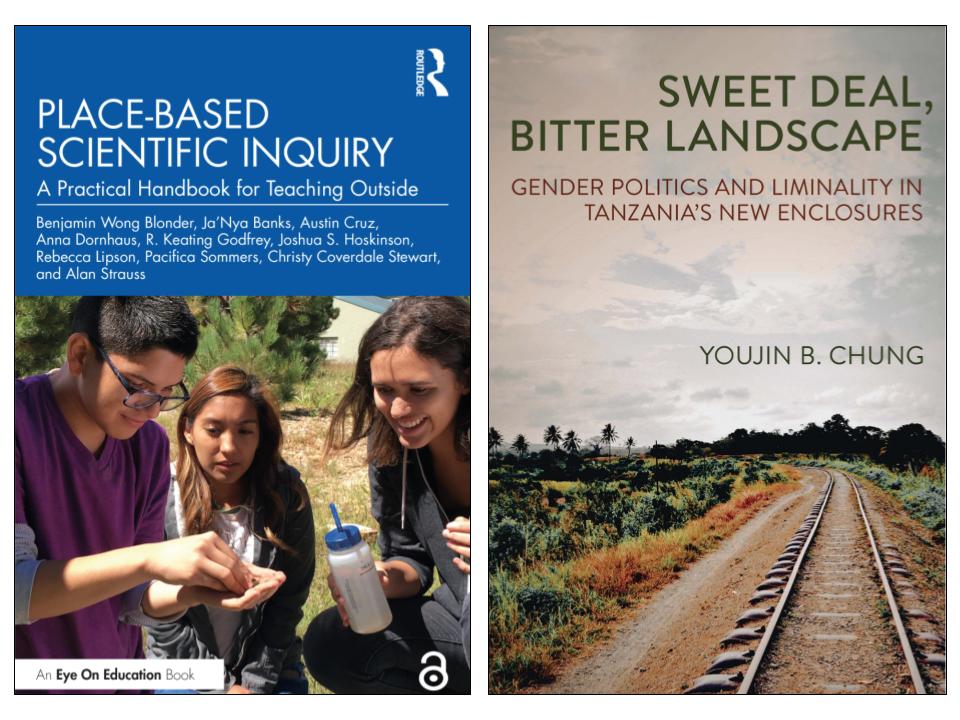
- Prof. Benjamin Blonder from the Department of Environmental Science, Policy, and Management (ESPM) published Place-Based Scientific Inquiry: A Practical Handbook for Teaching with Routledge (Taylor & Francis). The book is shared under the Creative Commons Attribution (CC BY) license and available as a free download.
- Prof. Youjin B. Chung, also from ESPM, published Sweet Deal, Bitter Landscape with Cornell University Press. The book is shared under the Creative Commons Attribution-NonCommercial-NoDerivatives (CC BY-NC-ND) license and available as a free download.
Springer Open Access books
In 2021, the UC Berkeley Library entered into an institutional open access book agreement with Springer Nature. The partnership provides open access funding to UC Berkeley affiliated authors who have books accepted for publication in Springer, Palgrave, and Apress imprints. This means that these authors can publish their books open access at no direct cost to them. The agreement covers all disciplines published by Springer. All the books are published under a Creative Commons Attribution (CC BY) license for free access and downloading. In the last year, several UCB-authored books have been published open access as a result of the UCB-Springer agreement.
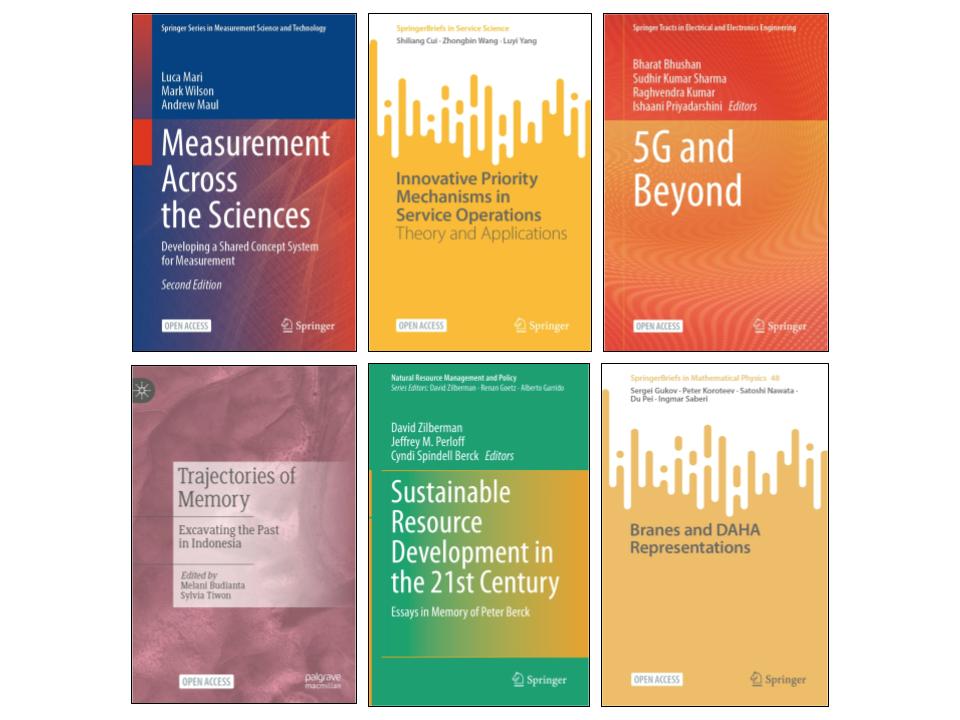
- Prof. Mark Wilson from the School of Education published Measurement across the Sciences (2nd Edition) with Springer.
- Prof. Luyi Yang from the Haas School of Business published Innovative Priority Mechanisms in Service Operations with Springer.
- Prof. Ishaani Priyadarshini from the School of Information published 5G and Beyond with Springer.
- Prof. Sylvia Tiwon from the Department of South & Southeast Asian Studies published Trajectories of Memory: Excavating the Past in Indonesia with Palgrave Macmillan.
- Profs. David Zilberman (Department of Agricultural and Resource Economics), Jeffrey M. Perloff (Department of Agricultural and Resource Economics), and Cyndi Berck published Agriculture & Resource Economics Sustainable resource development in the 21st century: Essays in memory of Peter Berck with Springer.
- Prof. Peter Koroteev from the Department of Mathematics published Branes and DAHA Representations with Springer.
University of California Press
UC Berkeley Library continues to support open access book publishing via Luminos, the open access arm of the University of California Press. The Library membership with Luminos means that UC Berkeley authors who have books accepted for publication through the UC Press can publish their book open access with a heavily discounted book processing charge. When combined with additional funding support through BRII, a UC Berkeley book author could potentially publish their book open access with the costs being covered fully by the Library. Luminos books are published under Creative Commons licenses with free downloads.
Pressbooks platform & workshops
The UC Berkeley Library hosts an instance of Pressbooks, an online platform through which the UC Berkeley community can create open access books, open educational resources (OER), and other types of digital scholarship.
The Office of Scholarly Communication Services OSCS continues to offer a bi-annual Pressbooks workshop and demo where participants can learn how to navigate the platform and create and publish their own eBooks and open educational resources. (Note: the next Pressbooks workshop is happening on April 9, 2024. Sign up now if you’re interested!)
Every year during the fall semester OSCS hosts an author panel to unpack the process of turning a dissertation into a book. One of the topics discussed during the panel are options for open access publishing. Here’s a recording of last year’s panel discussion.
UC contributing to the broader ecosystem of open access book publishing
A near term goal of the UC Libraries is to strategically advance open scholarship by extending its support for OA book publishing. At the systemwide level, the UC is supporting several open access book publishing ventures, including Opening the Future, MIT’s Direct to Open, and the University of Michigan Press’ Fund to Mission. In general, these models secure investments from libraries or other stakeholders, and agree to publish some or all of their frontlist books open access, with limited or zero direct cost to the authors. The backlist books are made accessible to participating institutions.
Wrapping up
In this post, we highlighted several ways that the University of California—and specifically UC Berkeley—is supporting scholarly authors to create and share open access books. In addition to providing financial assistance, platforms, and publishing guidance, the Library is committed to promoting the broader OA book publishing ecosystem. We’ll continue to explore a variety of approaches to support the UC Berkeley community (and beyond) who wish to publish books on open access terms.
If you’re interested to learn more about how you can create and publish an open access book, visit our website or send an email to schol-comm@berkeley.edu.
Il Tolomeo: rivista di studi postcoloniali
Hard to imagine the UC Berkeley Library as one that may soon not be able to afford new journal subscriptions but for better for worse, that’s where we are heading with serials reduction projects such as the one we undertook last year. It’s a good thing thing the open access movement is still gaining traction. It’s also a good thing universities like the Ca’ Foscari University of Venice are boldly choosing to publish their journals and some of their books this way.
Il Tolomeo: rivista di studi postcoloniali first saw the light of day in 1995, thanks to the work of a group of postcolonial scholars at Ca’ Foscari. The journal publishes peer-reviewed articles, reviews, interviews, and previously unpublished original contributions in the fields of francophone, anglophone and lusophone literatures. It investigates the postcolonial literary phenomenon in all its manifestations, but is particularly interested in contributions which take a comparative, interdisciplinary approach: dialogues between literature and the arts, investigations of hybrid forms such as comic strips and cinema, research which links literary studies with the social sciences, or innovative approaches such as digital and environmental humanities.
For its next issue, Il Tolomeo invites all interested scholars to send their contributions for the upcoming 2024 issue (no. 26). The issue will be divided into a generalist section (on any theme) and a thematic section dedicated to asylum, refugees and postcolonial literatures. The deadline for submitting complete contributions is May 20, 2024.
Workshop Reminder — From Dissertation to Book: Navigating the Publication Process on November 9, 2023
Date/Time: Thursday, November 9, 2023, 11:00am–12:30pm
Location: Zoom only. Register via LibCal.
Hear from a panel of experts—an acquisitions editor, a first-time book author, and an author rights expert—about the process of turning your dissertation into a book. You’ll come away from this panel discussion with practical advice about revising your dissertation, writing a book proposal, approaching editors, signing your first contract, and navigating the peer review and publication process.
Workshop Reminder — How to Publish Open Access at UC Berkeley on October 17, 2023
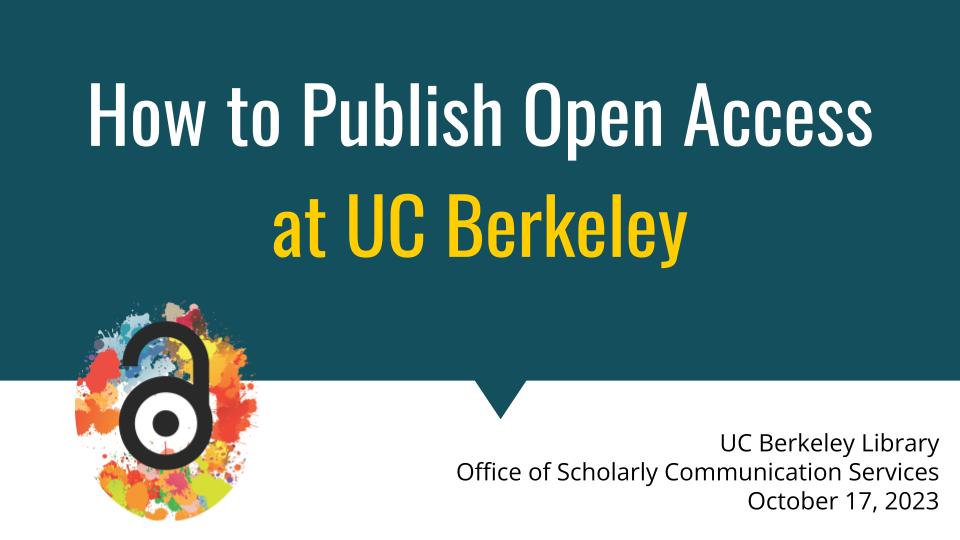
Date/Time: Tuesday, October 17, 2023, 11:00am–12:30pm
Location: Zoom only. Register via LibCal.
Are you wondering what processes, platforms, and funding are available at UC Berkeley to publish your research open access (OA)? This workshop will provide practical guidance and walk you through all of the OA publishing options and funding sources you have on campus. We’ll explain: the difference between (and mechanisms for) self-depositing your research in the UC’s institutional repository vs. choosing publisher-provided OA; what funding is available to put toward your article or book charges if you choose a publisher-provided option; and the difference between funding coverage under the UC’s systemwide OA agreements vs. the Library’s funding program (Berkeley Research Impact Initiative). We’ll also give you practical tips and tricks to maximize your retention of rights and readership in the publishing process.
Join us next week!
UC Berkeley author tips: What to do when you have to pay an open access publishing fee
This post provides information to UC Berkeley authors about programs that our Library and the UC system offer to help defray open access article processing charges. It also offers tips about how to plan or budget in advance for these fees when possible.
The University of California has been a long-time supporter of open access publishing—that is, making peer-reviewed scholarship available online without any financial, legal, or technical barriers. Just because the publishing outcome is open to be read at no cost, though, doesn’t mean the publishing enterprise as a whole is “free.” One of the most common ways for open access publishers to continue to finance their publishing and production of journals in the absence of selling subscriptions for access is to instead charge authors a fee to publish—moving from a publishing system based on paying to read to one based on paying to publish. Of course, not all methods of funding open access require authors to pay publication fees in this way. And in all cases (except those rare instances in which a publisher requests that you waive this right), the UC’s open access policy makes it possible for UC authors to share their author-accepted manuscript version of their articles on eScholarship, the UC’s research repository, immediately upon publication in a journal.
But when a publisher does charge a fee to publish, we want to help you understand what UC Berkeley resources are available—whether from your grant funds or the University of California Libraries—to help with those costs.
Typically publishers refer to author-facing fees as “article processing charges”, or “APCs”. APCs can range from a few hundred dollars all the way up to $10,000 or more for some select Nature journals.
UC authors may be able to cover or contribute to these fees by leveraging research accounts or grant funds (to the extent available). But there are also other University Library programs available to support payment when research accounts or grant funds are not available.
UC-wide open access publishing agreements will cover some (or all) APCs
UC corresponding authors can take advantage of funding opportunities to defray the cost of publishing their scholarship open access where their grant or other research funds come up short or are not available. The University of California libraries have entered into a growing number of systemwide transformative open access agreements with publishers. UC libraries’ transformative agreements aim to transform scholarly publishing by moving from a publication model based on subscription access to an open access model.
When a UC-affiliated corresponding author has an article accepted for publication in a journal with which the UC has an open access publishing agreement, the UC libraries will pay some or all of the associated publishing fee. So, when it comes time to pay the APC, the UC libraries will pay at least the first $1,000. If there’s any remaining balance due on the APC, the publisher’s payment system will ask if the UC author has grant funding available to cover the remainder. If the UC author cannot contribute the remaining balance, the UC libraries will pay the entire APC on their behalf. (Note: there are a few instances where the UC libraries will contribute a maximum of $1,000 toward the APC, such as Nature-branded titles.)
The UC maintains an updated list of Publisher OA Agreements and Discounts where you can explore which journals are available for partial or full APC coverage under the open access agreements.
The UC Berkeley Library-specific fund can reimburse open access fees for other fully open access journals
UC Berkeley’s Library also has a campus open access fund that UCB authors can use if they are publishing in a fully open access journal and are required to pay an APC. The Berkeley Research Impact Initiative (BRII) is open to any current UC Berkeley faculty, graduate student, postdoc, or academic staff who does not have other sources of funds to pay article processing charges. The BRII fund is available for journals other than those with which the UC has entered into a systemwide transformative open access agreement.
For BRII APC coverage to apply, the entire journal must be freely available to the public without subscription fees. BRII cannot cover fees for publishing in “hybrid” OA journals—which are subscription-based journals that only offer open access options if an author decides to pay an additional fee to make their individual article open access. BRII reimbursements are capped at $2,500 per article, and a UC Berkeley author can use BRII funds once per fiscal year.
How to plan in advance
If your research is grant funded, it is important to think about publishing costs at the beginning of your research cycle and account for them in your grant applications and annual research budgeting. For grant recipients (such as researchers with funding from NIH, NSF, etc.), open access publishing costs generally are considered an allowable direct expense unless funders explicitly prohibit them. For more information on how and why to plan in advance, check out the Open Access Fact Sheet for Researchers Applying for Grants.
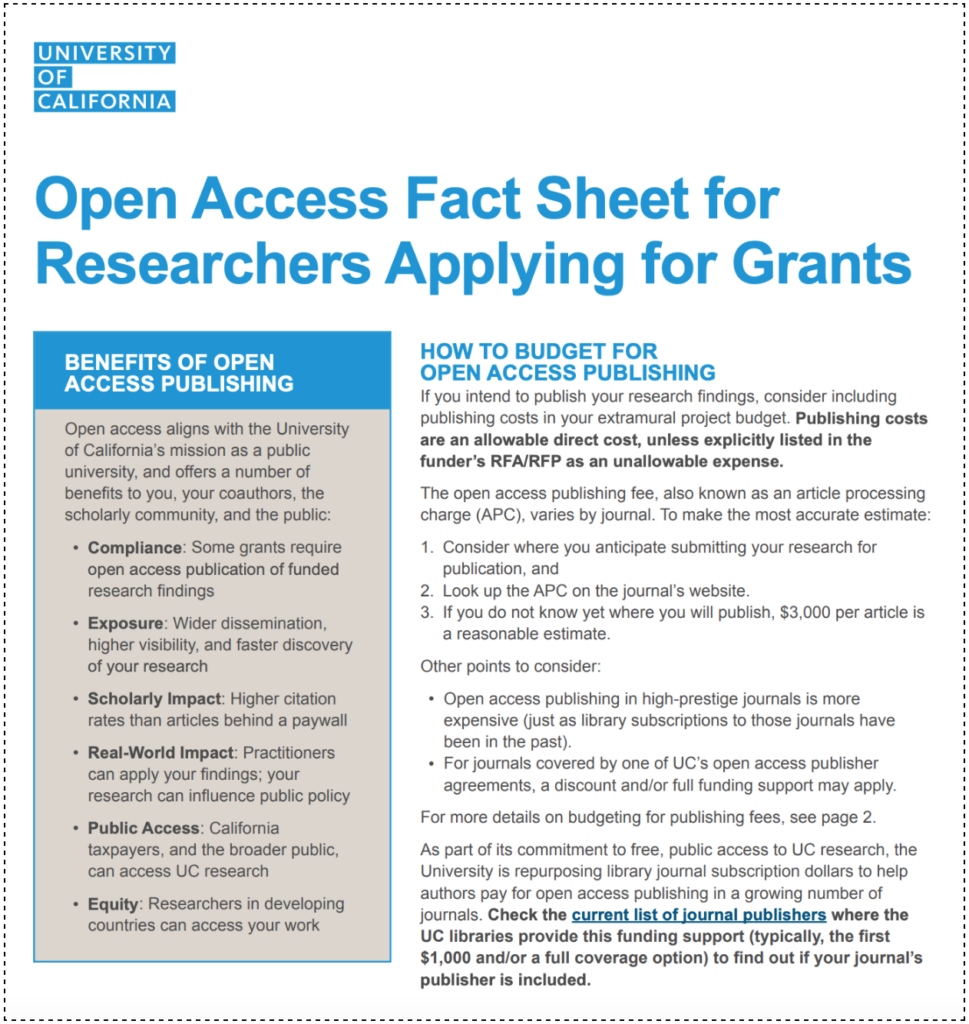
Planning in advance allows you to be a partner in the publishing process. It allows the UC libraries to cover some of your article processing charge ($1,000) and, where possible, you to use grant or research funds to cover the rest. The more researchers are able to contribute, the farther the UC agreements can go in publishing more articles open access, and the better UC libraries are able to help provide financial support to researchers who do not have specific access to grant funds.
Most of the UC transformative open access agreements are set up to cover the full article processing charge should UC authors not have research or grant funds to contribute to making their journal articles open access. But there are a few journal titles and series within transformative agreements for which the libraries were unable to negotiate full coverage. For example, if a UC author has an article accepted in Nature Communications, the UC libraries cover only the first $1,000 of the article processing charge through the terms of the UC-Springer Nature transformative open access agreement. Since the current APC for Nature Communications is $6,290, then the UC author must pay the remainder of the fee ($5,290).
Another instance in which an author may need to pay a balance is when the author is publishing in a fully-open access journal not covered by a transformative agreement at all, and in turn when that journal’s article processing charge exceeds what can be covered through the BRII program. For instance, if a UC Berkeley author has an article accepted for publication in JAMA Network Open, the BRII program is capped at covering $2,500 of the article processing charge. Since the APC for JAMA Network Open is $3,000, then the UC Berkeley author must pay the remainder of the fee ($500).
Since both of the examples above are journals in which an APC is required in order to publish there, authors are responsible for securing the remainder of any publishing fees should the open access publication costs exceed the amount of UC libraries (or UC Berkeley Library’s) support.
Need more help?
- Contact the Library’s Office of Scholarly Communication Services at schol-comm@berkeley.edu
- Read the Open Access Fact Sheet for Researchers Applying for Grants
- Explore the Open Access at UC webpage
- Explore the Open Access at Berkeley webpage
- Watch the YouTube workshop video How to Publish Open Access at UC Berkeley
- Visit the Berkeley Research Impact Initiative (BRII) website
Oral History Center Releases Documentary on Famed Yale Social Scientist James C. Scott
In A Field All His Own: The Life and Career of James C. Scott
“James C. Scott is regarded by many as one of the most influential thinkers of our time.”
The Oral History Center at UC Berkeley is proud to release, In A Field All His Own: The Life and Career of James C. Scott, a documentary that offers an unprecedented look at the famed Yale political scientist. Created and produced by UC Berkeley Oral History Center (OHC) historian Todd Holmes, the film draws from nearly thirty hours of oral history interviews with Scott and affiliated scholars at Yale and UC Berkeley to trace the intellectual journey of the award-winning social scientist from his childhood in New Jersey through each of the ground-breaking works he produced throughout his accomplished career. Overall, the film presents an intellectual biography of one of the world’s preeminent academics, a feature that will serve as a treasured resource for students and scholars around the globe.
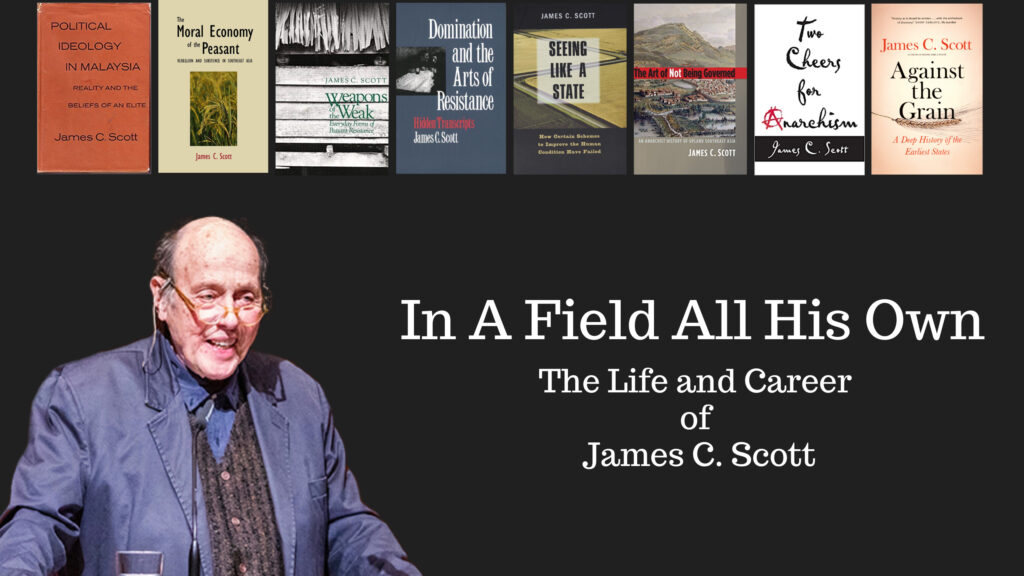
While intellectual biographies may not be a typical genre, Scott is far from a typical academic. Over the last fifty years, few scholars have achieved such prominence within the American academy as James C. Scott. The Sterling Professor of Political Science at Yale University, with appointments in anthropology and the school of forestry and environmental studies, he is regarded by many as one of the most influential thinkers of our time. Throughout his career, his scholarship became a series of major interventions that impacted dozens of disciplines across the humanities and social sciences. From the strategic rhythms of peasant life to notions of resistance and the functioning of the modern state, his work continually shaped and reshaped research agendas and discourses in the academy. By his retirement in 2022, Scott stood as one the most widely read social scientists in the world – an influence and distinction that placed him, as the film title suggests, “in a field all his own.”
The idea for the documentary developed out of the Yale Agrarian Studies Oral History Project, which Holmes conducted between 2018 and 2020. The focus of that project was to document the career of James C. Scott, as well as the thirty-year history of the renowned Yale Agrarian Studies Program he founded. Those oral history interviews, which the OHC released in 2021, served as the basis for the film. Holmes had worked for both Scott and the Agrarian Studies Program during his graduate studies at Yale. His motivation for both the project and documentary was to capture Scott’s story—in his own words—for future generations. As Holmes recalls, “I had the privilege of meeting and working with Jim Scott before ever reading Jim Scott, a unique vantage point that allowed me to develop a deep appreciation for the brilliant scholar behind the books—his limitless curiosity, his wit and humor, and the welcoming nature of his intellect. I wanted to capture these qualities in telling his story. His books will be read for generations to come; it was my hope that this film could serve as a companion and allow students and scholars to get to know James C. Scott and the inspiration behind his work.”
The film was made possible through the generous support of Yale University’s Program in Agrarian Studies, InterAsia Initiative, and Council on Southeast Asia Studies. It was produced by Todd Holmes in association with the UC Berkeley Oral History Center and Teidi Productions, a digital creations label he operates with his partner Heidi Holmes. The film is available to the public via YouTube.
About the Oral History Center
The Oral History Center of The Bancroft Library preserves voices of people from all walks of life, with varying political perspectives, national origins, and ethnic backgrounds. We are committed to open access and our oral histories and interpretive materials are available online at no cost to scholars and the public. You can find our oral histories from the search feature on our home page. Search by name, keyword, and several other criteria. Sign up for our monthly newsletter featuring think pieces, new releases, podcasts, Q&As, and everything oral history. Access the most recent articles from our home page or go straight to our blog home.
Spring bloom: new ebooks from OpenEdition
It’s that time of year when we choose new ebook titles from OpenEdition. Below you will find a few that have made it to the list. Please send other recommendations to the Librarian for Romance Languages by April 1.
Since 2014, the UC Berkeley Library has supported this initiative based at the Université d’Aix-Marseille to open scholarly content from Europe and France in particular to the world. The Freemium program allows the UC Berkeley community to participate in an acquisitions policy that both supports sustainable development of open access (OA) and that respects the needs of teaching, research and learning communities. With our participation, faculty, students, and other researchers can benefit from greater functionality while making it possible for anyone in the world to view in html and in open access 70% of the ebook catalog of more than 13,000 titles.
Through the Freemium model, UC Berkeley gains access to preferred formats (pdf, epub, etc.) with no DRM quotas and seamless access to the content with UC Library Search.
Workshop Reminder—How to Publish Open Access at UC Berkeley
Workshop Date/Time: Tuesday, October 25, 2022, 11:00am–12:30pm
RSVP for Zoom link
Please sign up today and join us on October 25.
Fall 2022 copyright and publishing workshops with the Office of Scholarly Communication Services

With the school year kicking off this week in Berkeley, the Office of Scholarly Communication Services is here to help UC Berkeley faculty, students, and staff understand copyright and scholarly publishing with online resources, Zoom workshops, and consultations.
Here’s what’s coming up this semester.
Workshops
Publish Digital Books & Open Educational Resources with Pressbooks
Date/Time: Tuesday, September 20, 2022, 11:00am–12:30pm
RSVP for Zoom link
If you’re looking to self-publish work of any length and want an easy-to-use tool that offers a high degree of customization, allows flexibility with publishing formats (EPUB, PDF), and provides web-hosting options, Pressbooks may be great for you. Pressbooks is often the tool of choice for academics creating digital books, open textbooks, and open educational resources, since you can license your materials for reuse however you desire. Learn why and how to use Pressbooks for publishing your original books or course materials. You’ll leave the workshop with a project already under way.
Copyright and Your Dissertation
Date/Time: Tuesday, September 27, 2022, 11:00am–12:30pm
RSVP for Zoom link
This workshop will provide you with practical guidance for navigating copyright questions and other legal considerations for your dissertation or thesis. Whether you’re just starting to write or you’re getting ready to file, you can use our tips and workflow to figure out what you can use, what rights you have as an author, and what it means to share your dissertation online.
Managing and Maximizing Your Scholarly Impact
Date/Time: Tuesday, October 11, 2022, 11:00am–12:30pm
RSVP for Zoom link
This workshop will provide you with practical strategies and tips for promoting your scholarship, increasing your citations, and monitoring your success. You’ll also learn how to understand metrics, use scholarly networking tools, evaluate journals and publishing options, and take advantage of funding opportunities for Open Access scholarship.
From Dissertation to Book: Navigating the Publication Process
Date/Time: Tuesday, October 18, 2022, 11:00am–12:30pm
RSVP for Zoom link
Hear from a panel of experts—an acquisitions editor, a first-time book author, and an author rights expert—about the process of turning your dissertation into a book. You’ll come away from this panel discussion with practical advice about revising your dissertation, writing a book proposal, approaching editors, signing your first contract, and navigating the peer review and publication process.
How to Publish Open Access at UC Berkeley
Date/Time: Tuesday, October 25, 2022, 11:00am–12:30pm
RSVP for Zoom link
Are you wondering what processes, platforms, and funding are available at UC Berkeley to publish your research open access (OA)? This workshop will provide practical guidance and walk you through all of the OA publishing options and funding sources you have on campus. We’ll explain: the difference between (and mechanisms for) self-depositing your research in the UC’s institutional repository vs. choosing publisher-provided OA; what funding is available to put toward your article or book charges if you choose a publisher-provided option; and the difference between funding coverage under the UC’s “transformative agreements” vs. the Library’s funding program (Berkeley Research Impact Initiative). We’ll also give you practical tips and tricks to maximize your retention of rights and readership in the publishing process.
Copyright and Fair Use for Digital Projects
Date/Time: Tuesday, November 8, 2022, 11:00am–12:30pm
RSVP for Zoom link
This training will help you navigate the copyright, fair use, and usage rights of including third-party content in your digital project. Whether you seek to embed video from other sources for analysis, post material you scanned from a visit to the archives, add images, upload documents, or more, understanding the basics of copyright and discovering a workflow for answering copyright-related digital scholarship questions will make you more confident in your project. We will also provide an overview of your intellectual property rights as a creator and ways to license your own work.
Other ways we can help
In addition to the workshops, we’re here to help answer a variety of questions you might have on intellectual property, digital publishing, and information policy.
- Check out our website for information on issues such as copyright and fair use, text data mining, and how to participate in UC’s Open Access Policy.
- Interested in publishing your research Open Access? UCB Library can help defray the costs of an article processing charge (up to $2,500) or book processing charge (up to $10,000). See the Berkeley Research Impact Initiative (BRII) for more information. And explore the various UC-wide transformative open access agreements and discounts that can help UC corresponding authors publish their scholarship open access.
- Do you want to create an open digital textbook? Take a look at UC Berkeley’s Open Book Publishing platform (anyone with a @berkeley.edu email can sign up for a free account), and get in touch with us about our Open Educational Resources (OER) grant program.
- Keep an eye on our events calendar for more workshops and trainings.
- Follow our blog, social media, and YouTube channel.
Want help or more information? Send us an email. We can provide individualized support and personal consultations, online class instruction, presentations and workshops for small or large groups & classes, and customized support and training for departments and disciplines.
Changes ahead for sharing open access articles on eScholarship

Note from October 21, 2022: this post has been updated with new rollout dates. Please see below.
If you are a University of California academic author who is employed at the UC but not part of the Faculty Senate, you will soon have a new way to post copies of scholarly articles you’ve written into eScholarship.org, the UC’s open access repository.
This blog post answers questions and provides assistance to those authors affected by this change.
What is happening?
There will be a procedural change to how certain UC authors upload copies of their scholarly articles to the UC’s institutional repository to make these articles available “open access.”
Publishing scholarship “open access” means making it available to be read online by anyone at no cost to the reader. Within the UC, there are many ways to publish “open access”, including by “depositing” or uploading a copy of your “author accepted manuscript” into the UC’s institutional repository. Author accepted manuscripts (or AAMs) are the final textual version of your article without publisher formatting and final copy edits.
What’s happening now are changes to how some of you may be doing the uploading of AAMs to eScholarship. Some UC Berkeley scholars (i.e. faculty senate authors) already use a special software system for the uploading process, whereas other scholars (i.e. anyone else employed within the UC who creates academic scholarship) instead upload AAMs directly to escholarship.org through the eScholarship website. Soon, everyone (that is both faculty and all other employees who create scholarly works) will begin using the special software system for uploading.
The software system is called UC’s Publication Management System. In addition to streamlining how you undertake the uploading of your AAMs, the software also proactively searches published literature for articles that it thinks you authored and should deposit. If the system identifies an article that it thinks you’ve published, you will receive an e-mail notification (on a bi-monthly basis) requesting that you upload your AAMs through the Publication Management System platform.
So, nothing is changing for you if you’re a faculty author who already has access to and uses the Publication Management System. But for all other academic authors within the University of California, you’re soon going to get a new way to deposit your AAMs to eScholarship, and will receive periodic e-mails letting you know when to do it.
Why is this happening?
The University of California has two open access policies addressing the deposit of AAMs into the eScholarship repository. One such policy pertains to Academic Senate faculty and has been in place since 2013. The other, called the Presidential Open Access Policy (because it was issued by the UC President in 2015), covers non-faculty authors. Specifically, the Presidential Open Access Policy includes non-senate researchers, lecturers, post-doctoral scholars, administrative staff, librarians, and graduate student employees.
California Digital Library, which oversees and manages the eScholarship repository, had already added everyone covered by the Academic Senate open access policy to the UC Publication Management System, making it easier for Academic Senate faculty to get their articles into eScholarship..
To date, however, authors covered by the Presidential Open Access Policy have only been able to upload their articles directly via the eScholarship website, and have not yet had access to the facilitation software. California Digital Library is now adding these “Presidential” policy authors to the Publication Management System, too.
Who is affected?
Scholarly authors who are employed by the UC and who are not part of the Faculty Senate.
Faculty Senate authors already use the UC Publication Management System software to upload their articles to eScholarship. Soon, non-Faculty Senate authors will also begin using the software to make their uploads, rather than uploading their AAMs directly via the eScholarship.org website.
How does the software work?
UC’s Publication Management System software searches multiple publication databases (such as Scopus, Web of Science, and others) to automatically locate scholarly articles written by UC authors, and sends them a periodic e-mail alert (about twice a month) to review the publications identified under their name, and upload a policy-compliant version of the article. The UC’s Open Access Policies grants covered authors the right to share their author accepted manuscript (the final, peer-reviewed, but not yet publisher-formatted version) immediately upon publication in a journal.
In addition to using the Publication Management System to claim and upload open access versions of articles, authors can also integrate scholarly profiles (such as ORCID), generate individual publishing reports, and get up-to-date statistics on the work they’ve authored while at the UC.
When is this happening?
The California Digital Library is rolling out the change over the course of a few months. This means that after the date outlined below, affected authors will begin to claim and upload their articles using the Publication Management System, and they’ll be notified via e-mail when there is an action they need to take.
If you are a non-Faculty Senate author in one of the following departments or units, you can expect California Digital Library to add you to the Publication Management System according to the following schedule:
June 2022
UC Berkeley libraries
July 2022 [New date: November 30, 2022]
Letters & Sciences – Arts & Humanities
Letters & Sciences – Biological Sciences
Letters & Sciences – Math & Physical Sciences
Letters & Sciences – Social Sciences
August 2022 [New date: January 18, 2023]
College of Chemistry
College of Environmental Design
College of Natural Resources
College of Engineering
September 2022 [New date: February 1, 2023]
UC Berkeley School of Law
Goldman School of Public Policy
Haas School of Business
School of Education
School of Information
School of Journalism
School of Optometry
School of Public Health
School of Social Welfare
March 1, 2023: All other academic units not situated under a college, school, or department classification mentioned above.
Where can authors get assistance?
Authors covered under the Presidential Open Access Policy can explore the UC Publication Management System now by logging in at https://oapolicy.universityofcalifornia.edu/. However, the Publication Management System will not begin sending e-mail notifications until the approximate rollout date indicated above.
California Digital Library maintains documentation and FAQs on how to navigate and use the Publication Management System, including helpful articles about how to get started with claiming and depositing your OA-compliant articles.
UC Berkeley Library staff are here to provide additional assistance. Please send your questions to oapolicy@lists.berkeley.edu and we’ll be in touch.
